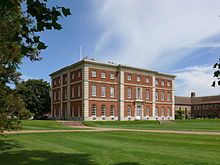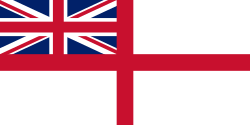George Bowyer
| Admirál Sir George Bowyer | |
|---|---|
 Kapitán George Bowyer (1768, Joshua Reynolds) | |
| Vojenská služba | |
| Služba | |
| Složka | |
| Hodnost | admirál 1799, viceadmirál 1794, kontradmirál 1794, kapitán 1762 |
| Narození | 3. května 1740 |
| Úmrtí | 6. prosince 1800 (ve věku 60 let) |
| Titul | baronet 1794 (povýšení), 1799 (dědictví) |
| Choť | Margaret Price (1768–1778) Henrietta Brett (od 1782) |
| Rodiče | Sir William Bowyer, 3rd Bt. a Anne Stonhouse |
| Děti | Sir George Bowyer, 6th Baronet Henrietta Bowyer unknown son Bowyer unknown daughter Bowyer |
| Příbuzní | Henry George Bowyer, Sir George Bowyer, 7th Baronet[1] a Sir William Bowyer, 4th/8th Bt.[1] (vnoučata) |
| Sídlo | Radley Hall |
| Profese | politik a námořní důstojník |
| Některá data mohou pocházet z datové položky. | |
Sir George Bowyer, 5. a 1. baronet (anglicky Sir George Bowyer, 5th Baronet Bowyer of Denham Court, 1st Baronet Bowyer of Radley Hall) (3. května 1740 Denham Court, Buckinghamshire, Anglie – 6. prosince 1800 Radley Hall, Oxfordshire, Anglie) byl britský admirál. Pocházel ze šlechtické rodiny a u královského námořnictva sloužil od dětství, na moři se zúčastnil válečných konfliktů druhé poloviny 18. století. Ve válkách proti republikánské Francii byl vážně zraněn v bitvě Slavného 1. června (1794). Následky zranění jej vyřadily z další aktivní služby, nakonec ale dosáhl hodnosti admirála (1799). Díky dědictví a vlastním akvizicím byl majitelem panství v několika hrabstvích.
Životopis
Pocházel ze staré šlechtické rodiny z Buckinghamshire připomínané od 15. století, narodil se na zámku Denham Court jako mladší syn Sira Williama Bowyera, 3. baroneta (1710–1767).[2] Jako kapitánský sluha vstoupil do námořnictva již v jedenácti letech, začínal pod kapitánem Richardem Howem. Sloužil u břehů západní Afriky, ve Středomoří a Karibiku. Na počátku sedmileté války se zúčastnil bitvy o Menorcu a v roce 1758 byl povýšen na poručíka. Dalších bojů se zúčastnil u břehů Francie a v Karibiku, v roce 1761 získal hodnost komandéra. V roce 1762 v boji s Francouzi u ostrova Ouessant padl do zajetí a ztratil loď, načež byl postaven před válečný soud, ten jej zprostil viny.

V roce 1762 dosáhl hodnosti kapitána, ale po sedmileté válce žil několik let mimo aktivní službu. Znovu byl povolán až během války proti USA, kdy s admirálem Byronem odplul do Karibiku a poté se připojil k loďstvu admirála Rodneye. Pod Rodneyovým velením se zúčastnil bitvy u Martiniku (1780) a několika dalších menších střetnutí s Francouzi. V roce 1781 se vrátil do Anglie a v hodnosti komodora velel od roku 1782 v ústí řeky Medway. V roce 1784 byl zvolen do Dolní sněmovny, kde podporoval vládu W. Pitta mladšího. Na půdě parlamentu vystoupil několikrát jako řečník k tématu námořnictva.[3] V Dolní sněmovně zastupoval volební obvod Queenborough v hrabství Kent, kde ve volbách v roce 1784 těsným výsledkem porazil admirála Hyde Parkera.[4] V následujících volbách v roce 1790 již nekandidoval. Mezitím získal v roce 1787 čestnou hodnost plukovníka námořní pěchoty (Royal Marines).

Na začátku válek s republikánskou Francií byl povýšen do hodnosti kontradmirála (1793) a připojil se k loďstvu Channel Fleet admirála Howea, svého prvního nadřízeného z počátku kariéry. Se svou lodí HMS Barfleur podnikl koncem května 1794 útok proti francouzskému loďstvu admirála Villareta de Joyeuse.[5] V následující bitvě Slavného 1. června byl vážně zraněn a musela mu být amputována noha. Za zásluhy obdržel státní penzi ve výši 1 000 liber ročně a získal titul baroneta s nárokem na titul Sir.[6] Titul of Radley Hall byl odvozen od názvu panství, které v roce 1792 zdědil po spřízněné rodině Stonhouse. Aktivně na moři již nemohl sloužit, ale v roce 1794 byl povýšen na viceadmirála a nakonec v roce 1799 dosáhl hodnosti admirála. Po bratru Williamovi (1736–1799) zdědil v roce 1799 starší rodový titul baroneta z Denham Court. Od názvu tohoto sídla byl později odvozen peerský titul barona Denhama, který potomci užívají dodnes. Současným představitelem rodu je George Grenville Bowyer, 3. baron Denham (*1959).[7]
Rodina a majetek
Kromě statků získaných dědictvím vlastnil také panství Warfield Grove v hrabství Berkshire, kde nechal postavit v georgiánském stylu zámek Warfield House.[8] Byl dvakrát ženatý. Poprvé se oženil v roce 1768 s Margaret Price, ovdovělou Downingovou (†1778), s níž neměl žádné potomstvo.[9] Podruhé se oženil v roce 1782 s Henriettou Brettovou (1753–1845), dcerou admirála a prvního námořního lorda Sira Peircyho Bretta. Z jejich manželství se narodilo šest dětí, dědicem rodových titulů a majetku byl syn Sir George Bowyer, 2. a 6. baronet (1783-1860), který byl řadu let poslancem Dolní sněmovny.[10]
Rodové sídlo Radley Hall bylo v 19. století prodáno a dnes je zde umístěna soukromá internátní škola Radley College. Jako připomínka účasti admirála Bowyera v bitvě Slavného 1. června bývá na budově školy každoročně 1. června vyvěšována britská vlajka.[11][12]
Odkazy
Reference
- ↑ a b Darryl Roger Lundy: The Peerage.
- ↑ Historie rodiny Bowyerů dostupné online
- ↑ George Bowyer na webu The History of Parliament dostupné online
- ↑ Volební obvod Queenborough na webu The History of Parliament dostupné online
- ↑ ŠŤOVÍČEK, Michal: Francie proti Evropě. Války revoluční Francie 1792–1802; Praha, 2017; 504 s. (kapitola Válka na moři: Britský Slavný 1. červen, s. 192–197) ISBN 978-80-7557-041-3
- ↑ KRÁLÍČEK, Václav: Lvi na vlnách. Anatomie námořních bojů Velké Británie s Francií v letech 1789–1794 v Atlantiku; Praha, 2018; s. 157 ISBN 978-80-7557-145-8
- ↑ Rodokmen rodu baronů z Denhamu dostupné online
- ↑ Zámek Warfield House na webu Royal Berkshire History dostupné online
- ↑ Sir George Bowyer na webu thepeerage dostupné online
- ↑ Sir George Bowywer, 2. a 6. baronet na webu The History of Parliament dostupné online
- ↑ Historie školy Radley College na webu radleyarchive dostupné online
- ↑ Admirál George Bowyer na webu morethannelson dostupné online
Literatura
- KOVAŘÍK, Jiří: Salvy pod plachtami, 1. díl (Námořní války Ludvíka XV. a Ludvíka XVI.); Praha, 2021; 367 s. ISBN 978-80-7497-348-2
- KOVAŘÍK, Jiří: Salvy pod plachtami, 2. díl (Revoluční a napoleonské války na moři); Praha, 2022; 396 s. ISBN 978-80-7497-418-2
- KRÁLÍČEK, Václav: Lvi na vlnách. Anatomie námořních bojů Velké Británie s Francií v letech 1789–1794 v Atlantiku; Praha, 2018; 200 s. ISBN 978-80-7557-145-8
Externí odkazy
Média použitá na této stránce
Autor: Andrew Gray, Licence: CC BY-SA 3.0
Radley Hall, Radley, Oxfordshire (formerly Berkshire), England, seen from the south west. Completed in 1727 as a country mansion. Since 1847 it has been the main building ("the Mansion") of Radley College.
The 'Defence' at the Battle of the First of June, 1794
An incident from the five-day battle known as the 'Glorious First of June 1794', during the French Revolutionary War, 1793-1802, between the British fleet under Lord Howe and the French fleet under Rear-Admiral Villaret-Joyeuse. This was the first great fleet battle of the French Wars of 1793-1815. It took place in the Atlantic, four hundred miles west of Ushant, when the French were attempting to intercept and escort home a valuable grain fleet from America and the British were also attempting to prevent this by capturing as much as possible. The consequent French manoeuvres allowed the British three days to position their fleet for the main attack.
Although Villaret-Joyeuse helped ensured the safe passage of the French grain convoy (which neither fleet sighted) by drawing off Howe, he also had to try and minimize damage to his warships. On the fourth day Howe caught up with the French and in the ensuing battle, six of their ships of the line were captured and one sunk. When the British 'Brunswick', 74 guns, fell foul of the French 'Vengeur du Peuple', 74 guns, her gunners alternately fired up through her decks and down below the waterline. The 'Vengeur du Peuple' eventually sank, an unusual occurrence for a wooden man-of-war as a result of enemy action. This is a detailed portrayal of a moment in the battle, around midday, which may have been witnessed by the artist from the deck of the 'Pegasus', 28 guns, in which he was present as an observer of the action.
The 'Defence', 74 guns, commanded by Captain James Gambier, was one of the most heavily engaged ships, and is shown demasted in the middle of the picture, in starboard-quarter tending to broadside view. It is firing into the French 'Achille', 74 guns, on the right of the picture, in starboard-quarter to stern view, which is returning her fire. On the left of the painting the 'Defence' is also being raked aft by a Frenchman, shown in starboard-bow view. The top rails of another French ship are visible beyond the 'Defence' and in the extreme left background is the stern view of an English three-decker. It is erroneously shown wearing the flag of an admiral of the white, since no admiral of the white was present at the action. However, the 'Defence' did serve in the division commanded by Benjamin Caldwell, Rear-Admiral of the White, in the 'Impregnable', 98 guns. The painting shows the ferocity of the action, with the deck and sides of the 'Defence' littered with broken spars and trailing rigging, the sails of the French ships holed and wreckage in the sea in the central foreground.
The artist filled a notebook with sketches and notes describing the course of the battle. He placed considerable importance on accuracy, and referred to his annotated drawings and sketch plans in the production of his oil paintings.
Pocock was born and brought up in Bristol, went to sea at the age of 17 and rose to command several merchant ships. Although he only took up painting as a profession in his early forties, he became extremely successful, receiving commissions from naval commanders anxious to have accurate portrayals of actions and ships. By the age of 80, Pocock had recorded nearly forty years of maritime history, demonstrating a meticulous understanding of shipping and rigging with close attention to detail. The painting is signed and dated 'N Pocock, 1811'.
A three-quarter-length portrait of George Bowyer (1740–1800) in captain’s full-dress uniform, 1767–87, with his right hand resting on his sword. He stands in front of overhanging rocks on the right with a distant view of a ship on rough seas on the left. Lettered beneath the image with the title, ‘Admiral Sir George Bowyer Bart.’ Also lettered with the production details and publication line: ‘Sir Joshua Reynolds / G. H. Every / London. Henry Graves & Compy, 6 Pall Mall, 1865.’ PU3040




